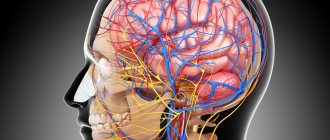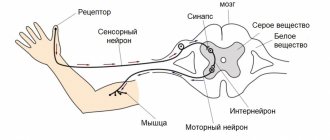Pain Treatment Center
Alekseeva
Oksana Alexandrovna
23 years of experience
Doctor, highest qualification category, member of the European Association of Neurologists, Russian Interregional Society for the Study of Pain (ROIB), Association of Interdisciplinary Medicine. Has experience working in hospital and outpatient services. He has seven published works on neurology.
Make an appointment
In ensuring the normal functioning of the human body, one of the key positions is occupied by the autonomic nervous system (ANS) - a complex of nervous structures responsible for maintaining a constant internal environment (homeostasis). The efforts of the ANS regulate the functioning of the circulatory and lymphatic systems, internal organs, and endocrine glands. The ANS itself is part of the nervous system (NS), but has an important feature - autonomy, that is, a person cannot control it with his own will.
Various disorders in the functioning of the ANS are called vegetative-vascular dystonia (VSD). This term does not mean a separate disease itself, but a syndrome - a condition caused by diseases of certain organs and systems (mental or somatic pathologies, hormonal imbalances).
Main symptoms and signs
The manifestations of VSD are diverse; the general list includes over several dozen items, but patients experience only a few of them (usually from 5 to 20) in different combinations. An important point: with VSD, there is a combination of several symptoms that appear simultaneously, but in the complete absence of organic disorders. A separate manifestation of any of these signs is not a reason for diagnosing vegetative-vascular dystonia, since it usually indicates a specific pathology.
Doctors distinguish several forms of VSD, classifying them on the basis of identifying relatively typical sets of symptoms that resemble the course of certain pathologies of organs or systems.
Respiratory form of VSD
Respiratory vegetative-vascular dystonia is the most common. The patient complains of the inability to take a deep breath, is afraid of suffocating, gasps for air, feels soreness, tightness in the throat, heaviness or pain in the chest, and coughs frequently.
Tachycardial form
Complaints of rapid heartbeat (tachycardia), irregular heart rhythm, sensation of vascular pulsation and heat in the temples and neck. It should not be confused with a similar picture with arrhythmia, paroxysmal tachycardia.
Cardiological form
In the area of the heart, pain of a different nature is noted (long-term aching or sharp, sharp), without a clear localization. During an attack of cardiac vegetative-vascular dystonia, the patient is anxious and breathes heavily. The pain lasts longer than with cardiovascular diseases (angina pectoris, myocardial infarction), does not depend on physical activity and is not relieved by appropriate medications (validol, nitroglycerin and others).
Hypotonic form
Characterized by dizziness, darkening of the eyes, sudden perspiration on the forehead, sweating, weakness, cold palms. Blood pressure drops briefly to 90/60 or below.
Hypertensive form
During an attack, tachycardia and heart pain are observed against the background of a short-term increase in blood pressure. The main difference from real hypertension: the pressure does not exceed 150/90.
Asthenic form
Performance decreases, complaints of fatigue, weakness, inability to concentrate, and sometimes body temperature rises slightly. Tremor (shaking in the hands) is possible, especially with the slightest physical exertion or a stressful situation. Irritability for no apparent reason or due to insignificant reasons, tearfulness.
Visceral form
Manifested by symptoms from the gastrointestinal tract (functioning disorder, nausea, diarrhea, vomiting, irritable bowel syndrome).
Mixed form
It combines certain signs characteristic of all the above forms of VSD, in arbitrary combinations.
Sometimes patients experience acute manifestations of symptoms, so-called attacks of dystonia or vegetative crises. An attack of VSD is characterized by sudden, spontaneous and rapid development, regardless of the circumstances. It can happen both during physical activity or a stressful situation, and at rest or sleep; alone or in a crowded place. Patients are afraid of suffocation, fear of death from respiratory or cardiac arrest, some feel feverish, others feel cold.
Separately, it is worth mentioning pre-syncope and fainting. They can have different origins; based on trigger mechanisms, they are distinguished:
- psycho-emotional - as a result of experiences, fear, reaction to the sight of blood;
- orthostatic - due to a sudden change in position, usually when abruptly getting up from a chair or bed;
- hypotonic – due to a sharp decrease in blood pressure.
Loss of consciousness is usually short-lived, lasting 1-3 minutes, the patient quickly comes to his senses. A history of fainting may indicate more severe pathologies, such as adrenal or cardiovascular insufficiency, nephropathy, or diabetes mellitus.
With such an impressive range of complaints, patients often do not experience any pathological changes in the structure or functioning of organs and systems. They often experience fear of developing a serious pathology, attributing to themselves some kind of disease based on similar signs. So, some fear paralysis due to mild numbness of the limbs or a heart attack due to chest pain.
Do you have symptoms of vegetative-vascular dystonia (VSD)?
Only a doctor can accurately diagnose the disease. Don't delay your consultation - call
Symptoms and features
Pregnant women with VSD are often bothered by discomfort in the heart area and palpitations.
In most cases, VSD begins to manifest itself in the early stages of pregnancy and can continue until birth. Symptoms of vegetative-vascular dystonia during pregnancy are as varied as in its absence.
The most common signs of VSD are:
- a sudden feeling of anxiety or fear;
- sleep disorders;
- prostration;
- feeling of heat on the face;
- hand trembling;
- feeling of coldness in the extremities;
- numbness of various parts of the body;
- increased sweating.
In more severe cases, VSD during pregnancy can provoke:
- dizziness and fainting;
- anemia;
- heartache;
- swelling.
The severity of symptoms of vegetative-vascular dystonia largely depends on the type of blood pressure disorder. With the hypotonic type of VSD, women may develop anemia and placental insufficiency. As the pathology worsens, the pregnant woman may experience weight loss, and the fetus may experience insufficient supply of nutrients and oxygen. Such violations can negatively affect its development.
With the hypertensive type of VSD, the risk of late toxicosis increases in a pregnant woman. In such cases, the severity of a woman’s condition can be aggravated by panic attacks and headaches.
The mixed type of VSD can have the most adverse effect on the course of pregnancy. Jumps in blood pressure negatively affect a woman’s condition and aggravate her mental instability with unpleasant sensations and anxiety. This type of dystonia, causing disruption of placental circulation, can also affect the condition of the unborn child.
Diagnostics
To begin with, the doctor, during a conversation with the patient, collects a detailed anamnesis - finds out the complaints, their nature, frequency of occurrence, the presence of a hereditary factor (are there people in the family who suffer from confirmed VSD).
Then a general examination is carried out, attention is paid to the patient’s behavior and his emotional background.
Due to the presence of symptoms similar to those of various other diseases (arrhythmia, hypertension, pathologies of the thyroid gland, gastritis, etc.), each patient with suspected VSD must undergo a detailed therapeutic examination in a clinical setting. To confirm the diagnosis of VSD, it is necessary to absolutely exclude diseases with similar symptoms. For this purpose, laboratory tests are prescribed:
- general blood analysis;
- general urine analysis;
- liver and kidney function indicators;
- analysis of thyroid hormone levels;
- clarifying tests at the discretion of the doctor.
Next, a referral is given for instrumental examinations, of which the most frequently used are:
- electrocardiography (ECG);
- echocardiography;
- 24-hour Holter blood pressure monitoring;
- fibrogastroduodenoscopy;
- Ultrasound of the abdominal organs, kidneys, neck vessels, thyroid gland;
- chest x-ray;
- spirometry;
- bicycle ergometry.
Sometimes the doctor requires additional diagnostic methods, such as computed tomography (CT), magnetic resonance imaging (MRI), electroencephalography, colonoscopy and others. Various functional tests are also carried out (psycho-emotional, orthostatic, physical exercise, pharmacological).
Causes of occurrence and development
The etiology of VSD, as well as its symptoms, is extremely diverse. Among the main reasons, doctors name:
- pathological changes that occurred during pregnancy or childbirth (intrauterine hypoxia, infectious process, birth injuries, etc.);
- changes in hormonal levels (during puberty or during hormonal therapy);
- hereditary tendency (presence of autonomic disorders in close relatives);
- traumatic brain injuries of any severity;
- traumatic stressful situation, frequent psycho-emotional stress;
- high mental stress;
- excessive, or conversely, insufficient physical activity;
- toxic effects of certain substances;
- unbalanced, irregular nutrition;
- long-term course of chronic diseases (diabetes mellitus, hypertension, coronary heart disease, bronchial asthma, hypo- and hyperthyroidism, gastric ulcer, etc.);
- chronic lack of sleep, sleep disorder;
- sudden changes in weather conditions or prolonged stay in a place with severe climatic conditions;
- the presence of foci of infectious agents (chronic sinusitis, rhinitis, otitis, tonsillitis, etc.);
- bad habits (smoking, alcoholism, drug addiction).
There are certain risk groups, people from whom are more likely than others to develop VSD: people who are underweight or overweight, have low resistance to stress, and occupy responsible positions; girls during puberty, women during pregnancy and menopause.
VSD during pregnancy
The debate about whether there is such a disease as vegetative-vascular dystonia has not subsided for many years. The term “VSD” was popular at the end of the twentieth century in the USSR, however, both at that time and today, Western doctors denied the existence of VSD as a separate disease. In previous years, the diagnosis of “VSD” covered a considerable number of various diseases, so the treatment that was prescribed often not only did not help, but also aggravated the condition of the patients. Currently, the global medical community believes that vegetative-vascular dystonia is a complex of dysfunctions of the cardiovascular system, which often manifests itself in the neurological sphere. According to international medical standards, it is more correct to consider such a health disorder not as a separate disease, but as a syndrome.
Scientists call the cause of this syndrome problems in the structure or functioning of certain parts of the human nervous system. The mechanism of development has not been fully studied to date. VSD syndrome rarely occurs for any one reason; more often the cause is a group of factors. It is known that stress, especially chronic stress, plays a huge role. The development of the syndrome is also influenced by past infectious diseases, some injuries (affecting the brain and bone marrow), less often the cause is the negative influence of the environment. One way or another, the functioning of the autonomic nervous system is disrupted, and in response there is a surge in pathological reactions and failures in the cardiovascular system.
- The manifestations of such violations can be very different (there are more than 150 of them in total), but most often they are:
- - headache,
- - dizziness,
- - weakness, fatigue,
- - bad mood, anxiety, excessive sensitivity,
- - increased heart rate,
- - fainting,
- - difficulty breathing,
- - change in complexion (pallor or, conversely, redness),
- - chills,
- - intestinal dysfunction.
Doctors make the diagnosis of “VSD syndrome” when they exclude all other possible causes that could give rise to such painful manifestations. Signs of VSD syndrome can be found in 70% of women.
Based on the grouping of symptoms, it is customary to distinguish several types of VSD syndrome. Classification varies, but most often the main types are called:
— Cardiac (the patient complains of interruptions in the heart rhythm, tachycardia, pain and heaviness in the chest, lack of air).
- Hypotonic (characterized by inhibited reactions, drowsiness, pallor, fainting, a sharp decrease in pressure).
— Hypertensive (due to vasoconstriction, even with minor physical activity, pressure increases significantly, heart rate increases, and headaches occur).
- Mixed (the most common type of VSD syndrome: combines symptoms of several types, attacks sometimes differ significantly from time to time).
Typically, dystonia during pregnancy complicates the nine months of waiting for a baby. It is impossible to say in advance how a particular organism will behave during pregnancy, but different types of syndrome require different approaches to its treatment, and many standard regimens are contraindicated during pregnancy. Drugs should be taken as a last resort, but even without them there are many ways to affect the body.
For example, with hypotension, hypoxia often occurs - a lack of oxygen, which is harmful for both the expectant mother and the child. Therefore, reasonable physical activity is important - moderate walking, water aerobics, swimming - and proper, timely nutrition (not only fresh seasonal vegetables and fruits of good quality, but also cereals, meat, milk). If a woman suffers from toxicosis and eats little, VSD syndrome can make her life simply unbearable. It is necessary, together with your doctor, to choose a diet that will meet the body’s needs and help you feel good.
With the hypertensive type, you should be wary of anemia, blood flow disorders, placental abruption and the development of late toxicosis, which means you need to do your best to fight edema, limit salt in the diet and be extremely careful about physical activity. Rapid weight gain should be absolutely excluded. In late pregnancy, it is advisable to undergo regular Doppler examinations. Hormonal changes in the female body against the background of this type of VSD syndrome are very difficult, and bed rest is the first assistant in such a difficult time. A hot heating pad applied to the back of the neck will help reduce pressure.
For cardiac type, it is best to use massage. A competent specialist will be able to have a beneficial effect on the cardiovascular system and alleviate the condition of the pregnant woman. A woman with the cardiac type of VSD syndrome should be especially careful about water procedures, because changes in water temperature may worsen the syndrome. A lot of fresh air (if it is not possible to walk, you should ventilate the room as often as possible) and sufficient sleep can work wonders for the well-being of a pregnant woman.
An integrated approach will help to cope with the mixed type of VSD syndrome, which will take into account all the individual characteristics of the patient.
A general recommendation for expectant mothers is to take vitamins and sedatives. Simple medicines such as valerian and motherwort tablets are very effective if you alternate them every ten days. The emotional state of the expectant mother has a huge impact not only on her own well-being, but also on the baby.
VSD during pregnancy can certainly be called a risk factor, because the load on the female body during the period of bearing a child increases many times over. But a positive attitude and attentive attitude of the woman and her doctor to various symptoms guarantee a decrease in the likelihood of developing serious vascular diseases and neurological problems. The key to success in the fight against VSD syndrome is unoriginal - a full, healthy lifestyle.
Treatment
Therapeutic measures consist of a set of effective methods, each of which is selected individually. Since most of the occurrences of VSD occur due to stress, it makes sense to pay attention to ways to combat them:
- normalization of sleep;
- rejection of bad habits;
- building an adequate work and rest regime, if necessary, the issue of changing jobs is considered;
- nutritious nutrition in compliance with the meal schedule;
- performing special sets of physical exercises, therapeutic exercises, yoga;
- work with a psychologist (individual or group classes, psychological trainings, consultations);
- physiotherapeutic procedures (massage, electrophoresis, contrast and therapeutic showers, etc.);
- Spa treatment.
All of the above methods are quite effective; when used, not only the disappearance of VSD symptoms is noted, but also an overall positive effect on the body as a whole.
Drug therapy for VSD
Prescription of medications is resorted to in case of ineffectiveness of non-drug measures. Treatment of VSD involves the use of medications strictly as prescribed by the doctor. Only a specialist determines the necessary drugs, their dosage and frequency of administration in each specific case. Among the main groups of medications are:
- sedatives of plant origin (normalize sleep, have a mild and effective effect);
- antidepressants – reduce anxiety, relieve headaches of varying intensity and duration;
- tonic and restorative drugs (improve tone, increase resistance to stress, physical and mental stress);
- metabolic agents – improve and normalize metabolic processes in the body, in particular in the brain and nervous system;
- tranquilizers - prescribed with caution, as they have clear indications and many side effects;
- microelements and vitamins;
- drugs aimed at eliminating various specific symptoms and their causes (hypotensive, antiarrhythmic, prokinetics, antispasmodics, etc.).
The patient must understand that VSD does not belong to the category of severe pathologies. With proper treatment and strict adherence to medical recommendations, recovery is guaranteed. The right attitude towards recovery plays an important role, when a person is not afraid of the manifestations of dystonia, but strives to overcome them. This is especially true for attacks of anxiety, restlessness, and various phobias - as soon as the groundlessness of such fears is realized, they gradually disappear forever.
Therefore, it is very important not to be afraid to talk about the problem. Sometimes patients are embarrassed by this and are in a vicious circle when they cannot cope with the problem on their own, but do not dare to visit a doctor. And it’s completely in vain, because already during a conversation with a specialist it turns out that it is much easier to cope with the situation together, moreover, the prognosis is favorable.
How does pregnancy affect the course of VSD?
Vegetative-vascular dystonia during pregnancy significantly complicates its course.
Moreover, it can be difficult to recognize the problem due to the similarity of the symptoms of the disease and the physiological conditions characteristic of the period of bearing a child. To make a diagnosis, it is necessary to take into account the manifestation of symptoms of VSD during pregnancy:
- tachycardia and heart pain, which are characteristic of the cardiac type of VSD;
- an increase in blood pressure (BP) or a decrease in it. Elevated blood pressure is characteristic of hypertensive type VSD, and low blood pressure is characteristic of hypotonic type. VSD of the hypotonic type during pregnancy is much less common;
- dyssomnia (sleep disturbances), irritability, nausea, frequent headaches, panic attacks.
The risks of pregnancy with VSD are due to the increased load on the circulatory organs due to the growing fetus. The renin-angiotensin-aldosterone (RAAS) system is activated, causing the kidneys to secrete more renin. This hormone narrows the lumen of blood vessels and leads to increased pressure. In addition, cascade reactions are triggered that lead to the production of angiotensin and aldosterone. The first increases diastolic (lower) readings, the second leads to swelling due to the accumulation of fluid in the body.
In some cases, the occurrence of vegetative-vascular dystonia in pregnant women is caused by activation of the sympathetic-adrenal system. Cortisol, secreted under the influence of the pituitary gland, increases the stroke volume of the heart and increases the sensitivity of vascular receptors to the action of adrenaline and norepinephrine. The result is vasoconstriction (spasm of the arteries and veins), which aggravates hypertension and can impair blood flow in the placenta.
In addition, one of the reasons for the exacerbation or appearance of VSD during pregnancy is a high level of homocysteine. This leads to swelling and increased blood pressure, which can cause disruption of placental blood flow.
Doctors treating VSD
In addition to the attending physician, a neurologist, endocrinologist, otolaryngologist, ophthalmologist, and instrumental diagnostic specialists take part in the process of diagnosing VSD. Depending on the symptoms, you may need to consult a specialist doctor - cardiologist, gastroenterologist, pulmonologist, urologist and other related specialties.
At the clinic of JSC “Medicine”, a comprehensive approach allows us to accurately establish the mechanisms of the occurrence and development of VSD, triggers, and timely identify or exclude concomitant pathologies. Doctors of the highest category with many years of experience, doctors of medical sciences, practice here. This is the key to successful treatment, but much depends on the patient himself: how timely he sought qualified medical help, how carefully he followed the doctor’s instructions for diagnosis and treatment.
Release form and composition
The tablets are white, biconvex, round, film-coated. Pharmacies receive the drug packaged in a cardboard box with a blister inside. It contains 20 tablets. Active ingredients of the drug: thiamine hydrochloride - 100 mg, pyridoxine hydrochloride - 200 mg, cyanocobalamin - 200 mcg. All these B vitamins are an indispensable source for the functioning of protein, carbohydrate and fat metabolism in our body, as well as the regulation of the activity of the central and peripheral nervous system. The following excipients were used: microcrystalline cellulose - 80 mg, magnesium stearate - 4.8 mg, povidone - 15 mg.
Available in ampoules of 2 ml each. The ampoule is made of light-protective glass with a light blue ring for breaking. The vitamin complex is packaged in blisters with cells. Each blister contains 5 ampoules. The manufacturer produces ampoules for intramuscular administration in sealed cardboard boxes with 1, 2 or 5 blisters inside. Active ingredients of the drug: pyridoxine hydrochloride - 100 mg, thiamine hydrochloride - 100 mg, cyanocobalamin - 1 mg. Additional substances in the composition are diethanolamine 5 mg and water for injection up to 2 ml.
The attending physician prescribes a specific release form to the patient depending on the current clinical situation.
Indications for treatment
The main indication is a clinically confirmed diagnosis of vegetative-vascular dystonia. Since VSD is a syndrome, the indications for its therapy correspond to disorders of various etiologies: vascular, psychological, neurological, cardiological and many others.
If your professional responsibilities involve high mental and emotional stress, stressful situations, overwork, or if you have a hereditary predisposition to VSD, sign up for a consultation with a specialist. Timely prevention will help avoid worsening problems, because the disease is easier to prevent than to treat.
Contraindications
Contraindications for the treatment of VSD are determined by the methods used. If we talk about drug therapy, then almost every drug has contraindications for use. The same can be said about physiotherapeutic procedures. That is why the course and tactics of treatment are determined by a highly qualified doctor who is able to take into account all factors.
There is one contraindication that is simultaneously applicable in all cases - self-treatment. In the case of VSD, this is especially true, since such patients are often excessively suspicious and tend to attribute severe pathologies to themselves. In an attempt to treat a non-existent disease, they can not only significantly aggravate their situation, but also cause irreparable harm to the body.
Cost of initial appointment, diagnostic examinations and treatment
As for the initial appointment, its cost in most cases is low; in fact, it is a consultation procedure. But one should not neglect its importance - an experienced doctor is able to recognize characteristic symptoms and notice even small but important manifestations of abnormalities.
The price of diagnostic procedures and laboratory tests may vary significantly in different clinical cases. For one patient, general tests and several examinations will be enough; for another, diagnosis may take longer and require additional studies and tests. This is due to both the complex nature of VSD and the individual characteristics of each patient’s body.
A similar picture is typical for treatment. Its cost is determined by many factors; sometimes the therapeutic process has to be adjusted. To roughly navigate the prices for diagnosis and treatment of VSD in Moscow, you can familiarize yourself with the corresponding table of costs for the most common diagnostic procedures.
Is it possible to give birth with VSD?
Treatment of VSD throughout the entire period of pregnancy allows you to give birth independently without surgery.
In the case when a woman is faced with the problem of exacerbation of VSD while already pregnant, it is very important to start treatment in a timely manner. This will prevent consequences for the expectant mother and fetus. Doctors are convinced that it is very possible to carry and give birth to a healthy child with such a pathology. The main thing is not to ignore painful symptoms and, when they first occur, consult a doctor for help.
Advantages of treating VSD at the clinic of JSC "Medicine"
Vegetative-vascular dystonia is a multifactorial disorder in the body; its successful treatment requires an integrated approach and coordinated work of doctors of many specialties. Among the undeniable advantages of JSC “Medicine” (clinic of academician Roitberg), it is worth mentioning 3 key points:
- High professionalism of doctors - the staff consists of more than 300 experienced practicing doctors and diagnosticians of 67 medical specialties. Leading corresponding members of the Russian Academy of Sciences, academicians, professors, doctors and candidates of medical sciences advise here. The clinic was the first in Russia to receive accreditation according to the international standards for assessing the quality of medical care JCI. Joint Commission International, considered the highest level of accreditation worldwide.
- Ultra-modern technical base - equipped with the latest generation diagnostic and treatment equipment from the world's leading manufacturers. This allows you to create your own scientific and clinical developments in almost all medical areas. For many years, the clinic of JSC "Medicine" has served as a clinical base for the Department of Therapy and Family Medicine of the Russian National Research Medical University named after N.I. Pirogov (RNIMU) and is among the innovatively active healthcare institutions in Moscow.
- High-quality medical care - the effectiveness and safety of treatment is guaranteed by the principle of Academician N.A. Semashko, which states: “One patient - one doctor.” The attending physician is assigned to each patient and works closely with colleagues from related medical specialties. A developed diagnostic base and medical care technology built according to international standards make it possible to make a diagnosis at an unprecedented speed. In just 1 day from the moment of the initial examination and diagnostic measures, you can receive detailed results of laboratory tests, detailed diagnostic reports and doctor’s recommendations.
It is important to know: VSD is not a critically severe disorder, but can provoke one in the absence of proper medical care. In case of early access to a doctor, treatment time is significantly reduced and financial costs are reduced. Don’t delay your visit, make an appointment at a time convenient for you, and we will help you regain your health!









